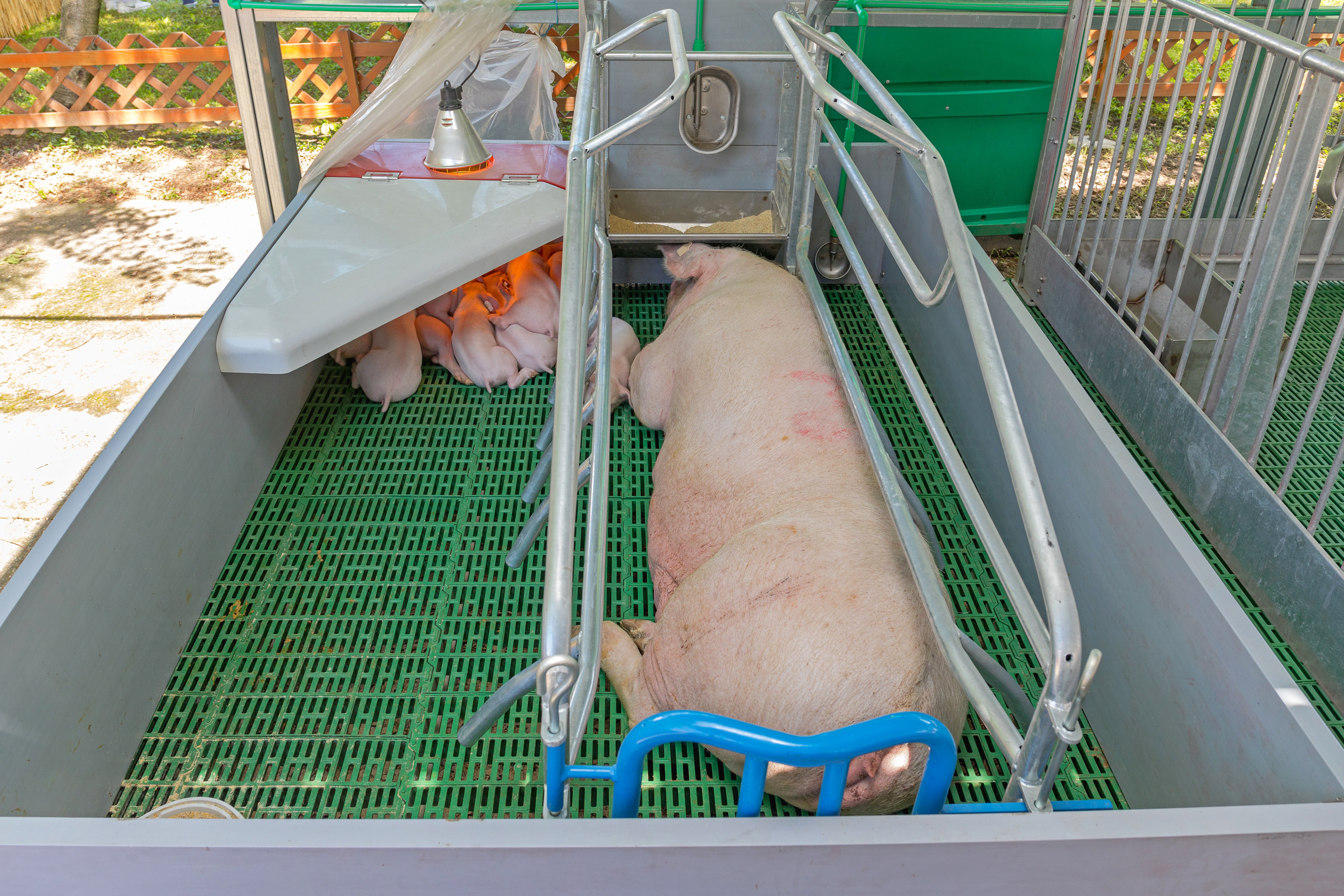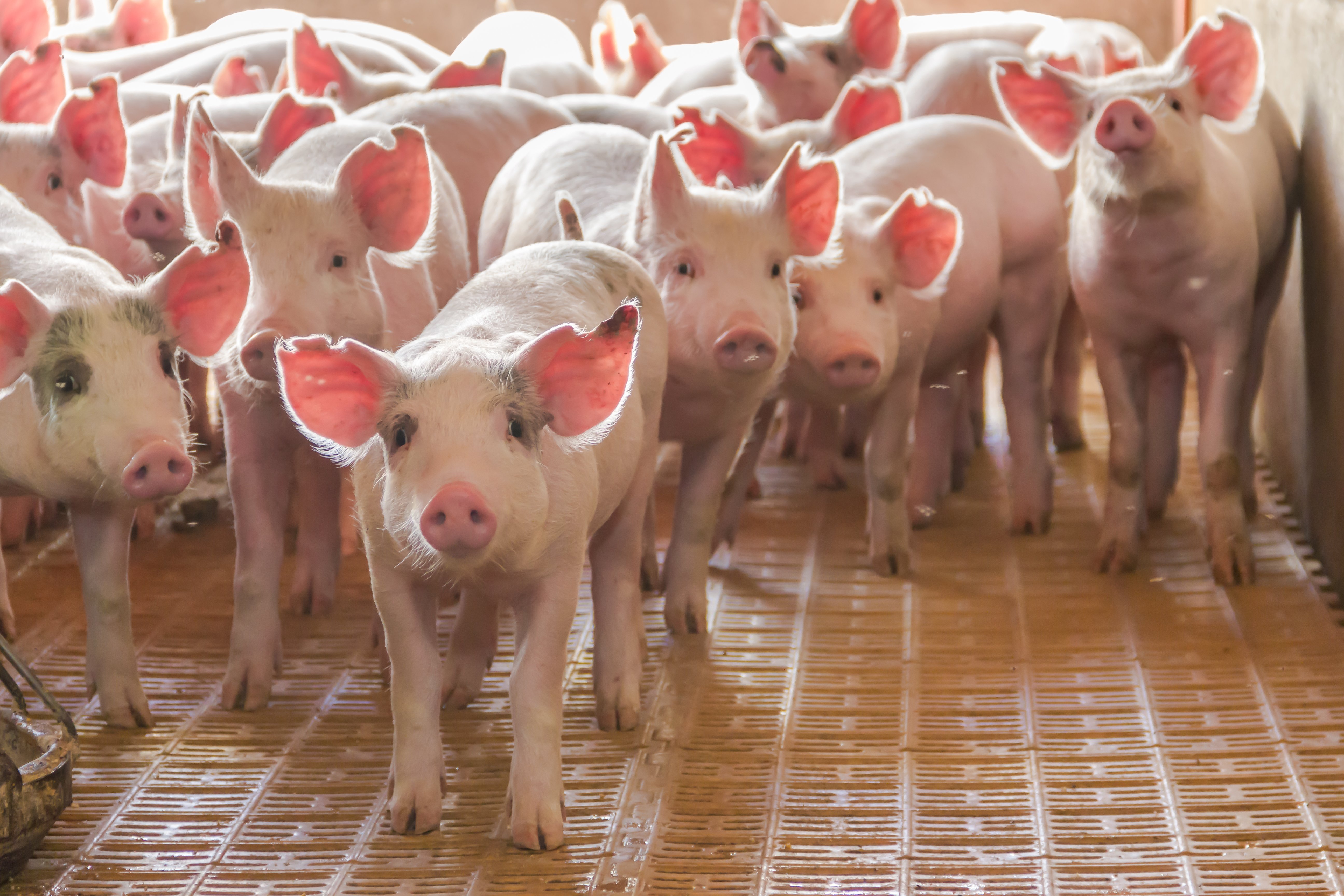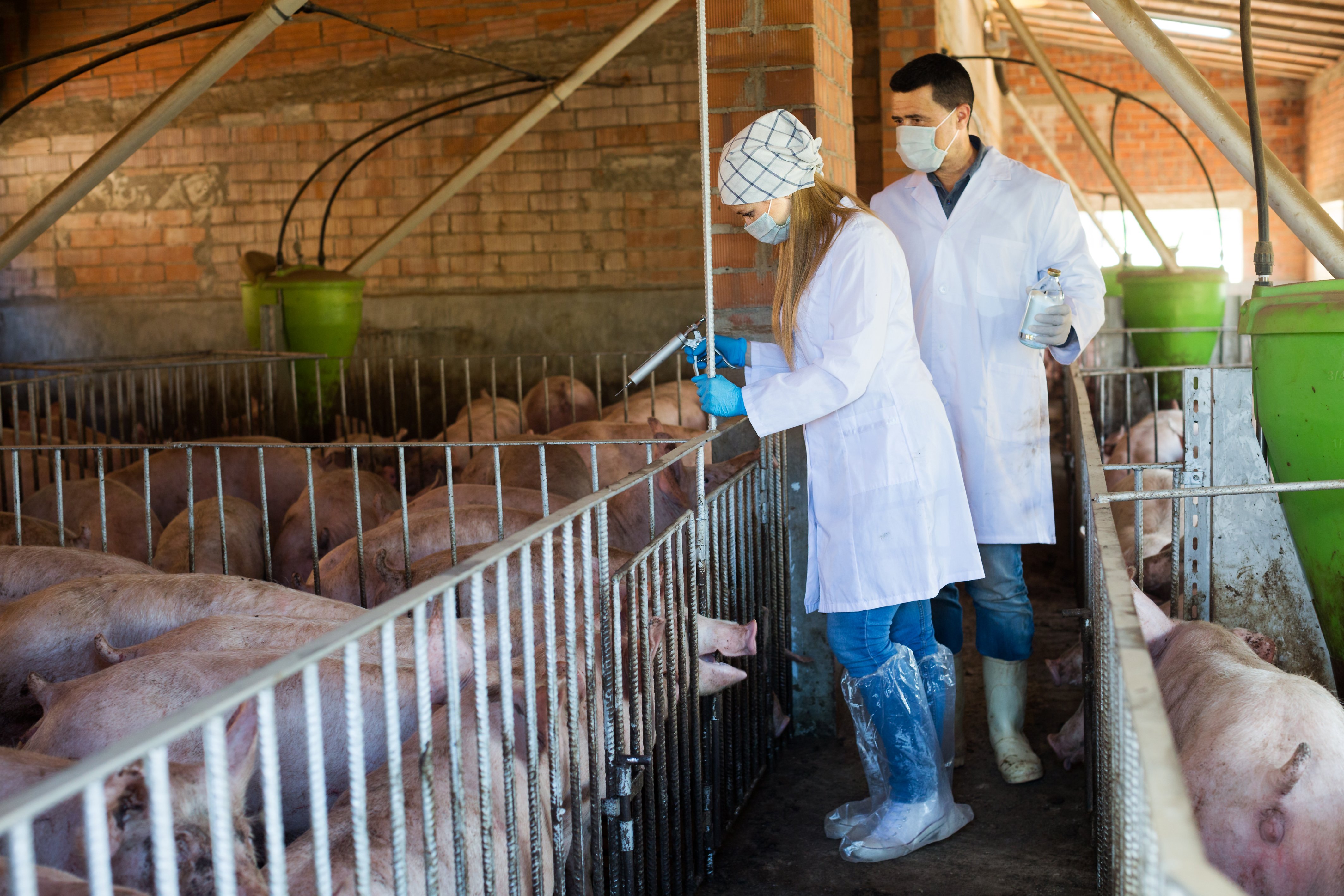17 November 2022
Piglet immune system
- Inducing death (apoptosis) in virus-infected or cancerous cells
- Releasing cytokines to attract and activate macrophages
- Induce the proliferation and differentiation of immune cells
Piglet immunisation
- Sow body score at previous weaning: sows that lose too much weight during lactation will need more days to next farrowing, but they will also have inadequate colostrum production.
- Gilt acclimatisation: replacement stock must be adequately acclimatised to common pathogens present in the farm, especially PRRSV.
- Sow vaccination: sows must be vaccinated a few weeks before farrowing (depending on the vaccine) to produce colostrum with antibodies against the most important pathogens.
- Stockmanship: stress in the days leading to farrowing can cause the colostrum to spill or production to be inadequate.
- Farrowing unit management: heat stress is an important cause of hypogalactia and agalactia (lower or no milk production).
- Sow nutrition: sows change their food intake before and after farrowing. The diet must be formulated to meet the demands of lactation.
- Nesting behaviour: before farrowing, sows display behaviours that kickstart and reinforce a chain of hormonal changes. Farrowing pen design and —depending on the production system— providing nesting material facilitates colostrum and milk production.
- Judicious use of oxytocin: while sometimes necessary, oxytocin has a negative effect on colostrum.
- There are not enough teats available in very large litters
- Heavier piglets prevent the runts from suckling (heterogeneous litters have this issue)
- Some piglets are born too weak to feed on their own
- Piglets become lethargic due to chilling
- The sow did not produce colostrum
- Dystocia (a difficult or prolonged farrowing, as well as stillbirths, are correlated with poor colostrum or reduced intake)
- Sow death
- Split suckling: split piglets from heterogeneous or large litters into two groups, place one group in the heated creep area and allow the other to suckle. Alternate between groups.
- Cross fostering: place ‘surplus’ piglets with another sow that has available teats. If possible, piglets should receive colostrum from their dam before cross fostering.
- Teat training: guide weak and light piglets towards the teat, until a feeding rhythm is established.
- Manual feeding: provide colostrum with a bottle. Cow colostrum can be used as a substitute. If there is no colostrum available, an energy mixture can be given with a syringe to promote that low-viability piglets feed on their own. Manual feeding is usually not financially sound in large farms.
 A heated creep area prevents chilling but also allows for split suckling, one of the most powerful colostrum management techniques.
A heated creep area prevents chilling but also allows for split suckling, one of the most powerful colostrum management techniques.
Farrowing pen pathogens
Escherichia coli
Sows are usually vaccinated a few weeks before farrowing.
Clostridium perfringens
Rotavirus
Porcine Reproductive and Respiratory Syndrome virus (PRRSV)
Porcine Circovirus type 2 (PCV2)
Coccidia
Importance of sow vaccination
What we can achieve through piglet active immunisation is very limited. Therefore, our efforts should centre around the sow and passive immunity transfer. Through sow vaccination, we can influence outcomes in the farrowing unit and beyond.
Sow vaccination programs depend largely on the challenges that the farm faces and on the region. However, with some exceptions, sows should be vaccinated against E. coli, C. perfringens types A and C, parvovirus and erysipelas. Although PRRSV and PCV2 vaccination should also be considered on positive and problematic farms. There are several transmissible gastroenteritis (TGE) vaccines available, however, it is not clear how effective they are preventing disease in piglets.

Sow immunisation protects piglets indirectly, through passive immunity transfer.
Impacts of active immunisation
Immunisation is one of the best methods at our disposal to prevent diseases in pig farming. We have very effective vaccines against some important pathogens of swine. Piglet immunity can be managed through sow pre-farrowing vaccination, colostrum management, and the active immunisation of piglets as soon as it is viable to do so.
To bring home the importance of immunisation through vaccines, we should remember that some of the biggest challenges and threats to the pig industry are diseases where we don’t have a vaccine, or where it provides variable protection: PRRSV, ileitis, and coccidiosis.
Every farm should decide which vaccines to use depending on several factors:
- Cost/benefit analysis
- Diseases prevalent in the region
- Diseases prevalent on the farm
- Local regulations
Tighter biosecurity, farrow-to-finish systems and all-in all-out management help to control pathogens and reduce the need to vaccinate in some situations. However, the context should always be taken into account. Normally, technified farms cannot afford not to vaccinate, as the risks of an outbreak are just too severe.
Importance of iron supplementation for piglets
We must not forget that the immune system is not limited to antibodies. Innate immunity, the gut microbiome, and non-specific immunity all play a role in keeping piglets healthy.
One of the greatest challenges of modern piglets is that, due to their fast growth rate, they quickly outgrow their iron reserves. Iron is an important component of haemoglobin, the protein in red blood cells responsible for oxygen transport.
Due to its unique chemical characteristics, iron is also involved in many other cellular interactions, including many pertaining to immunity. For example, neutrophils (a type of immune cell) kill bacteria through oxidation, but, without iron, the enzyme they use to produce oxidative compounds is inactivated (Cherayil, 2010).
Iron is also necessary for normal cell function. Iron-dependence is something shared by many life forms. In fact, one of the most curious mechanisms that the organism uses to fight bacteria is to deprive them of iron by keeping it inside the cells. For reasons that are not yet clear, lymphocyte differentiation is iron-dependent (Cherayil, 2010). This means that, without iron, lymphocytes get stuck in a stage of development. This impairs adaptive immunity.
Iron supplementation in piglets is, therefore, one of the most cost-effective ways to prevent piglet anaemia and to boost immunity.
References
Alexopoulos, J. G., Lines, D. S., Hallett, S., & Plush, K. J. (2018). A review of success factors for piglet fostering in lactation. Animals, 8(3), 38. https://doi.org/10.3390/ani8030038
Bandrick, M., Pieters, M., Pijoan, C., & Molitor, T. W. (2008). Passive transfer of maternal Mycoplasma hyopneumoniae-specific cellular immunity to piglets. Clinical and Vaccine Immunology, 15(3), 540-543. https://doi.org/10.1128/CVI.00466-07
Cabrera, R. A., Lin, X., Campbell, J. M., Moeser, A. J., & Odle, J. (2012). Influence of birth order, birth weight, colostrum and serum immunoglobulin G on neonatal piglet survival. Journal of Animal Science and Biotechnology, 3(1), 1-10. https://doi.org/10.1186/2049-1891-3-42
Cherayil B. J. (2010). Iron and immunity: immunological consequences of iron deficiency and overload. Archivum Immunologiae et Therapiae Experimentalis, 58(6), 407–415. https://doi.org/10.1007/s00005-010-0095-9
Declerck, I., Dewulf, J., Decaluwé, R., & Maes, D. (2016). Effects of energy supplementation to neonatal (very) low birth weight piglets on mortality, weaning weight, daily weight gain and colostrum intake. Livestock Science, 183, 48-53. https://doi.org/10.1016/j.livsci.2015.11.015
Declerck, I., Dewulf, J., Sarrazin, S., & Maes, D. (2016). Long-term effects of colostrum intake in piglet mortality and performance. Journal of Animal Science, 94(4), 1633-1643. https://doi.org/10.2527/jas.2015-9564
Declerck, I., Sarrazin, S., Dewulf, J., & Maes, D. (2017). Sow and piglet factors determining variation of colostrum intake between and within litters. Animal, 11(8), 1336-1343. https://doi.org/10.1017/S1751731117000131
Farmer, C., Devillers, N., Rooke, J. A., & Dividich, J. L. (2006). Colostrum production in swine: from the mammary glands to the piglets. Pig News and Information, 27(1).
Muns, R., Manteca, X., & Gasa, J. (2015). Effect of different management techniques to enhance colostrum intake on piglets’ growth and mortality. Animal Welfare, 24(2), 185-192.
Muns, R., Silva, C., Manteca, X., & Gasa, J. (2014). Effect of cross-fostering and oral supplementation with colostrums on performance of newborn piglets. Journal of animal science, 92(3), 1193-1199. https://doi.org/10.2527/jas.2013-6858
Opriessnig, T., Patterson, A. R., Madson, D. M., Pal, N., Ramamoorthy, S., Meng, X. J., & Halbur, P. G. (2010). Comparison of the effectiveness of passive (dam) versus active (piglet) immunization against porcine circovirus type 2 (PCV2) and impact of passively derived PCV2 vaccine-induced immunity on vaccination. Veterinary Microbiology, 142(3-4), 177-183. https://doi.org/10.1016/j.vetmic.2009.09.056
Pileri, E., & Mateu, E. (2016). Review on the transmission porcine reproductive and respiratory syndrome virus between pigs and farms and impact on vaccination. Veterinary Research, 47(1), 1-13. https://doi.org/10.1186/s13567-016-0391-4
Richard, O. K., Grahofer, A., Nathues, H., & Posthaus, H. (2019). Vaccination against Clostridium perfringens type C enteritis in pigs: a field study using an adapted vaccination scheme. Porcine Health Management, 5(1), 1-9. https://doi.org/10.1186/s40813-019-0127-8
Shin, S., Park, S. H., Park, J. H., Kim, S. M., & Lee, M. J. (2022). Age-Dependent Dynamics of Maternally Derived Antibodies (MDAs) and Understanding MDA-Mediated Immune Tolerance in Foot-and-Mouth Disease-Vaccinated Pigs. Vaccines, 10(5), 677.
